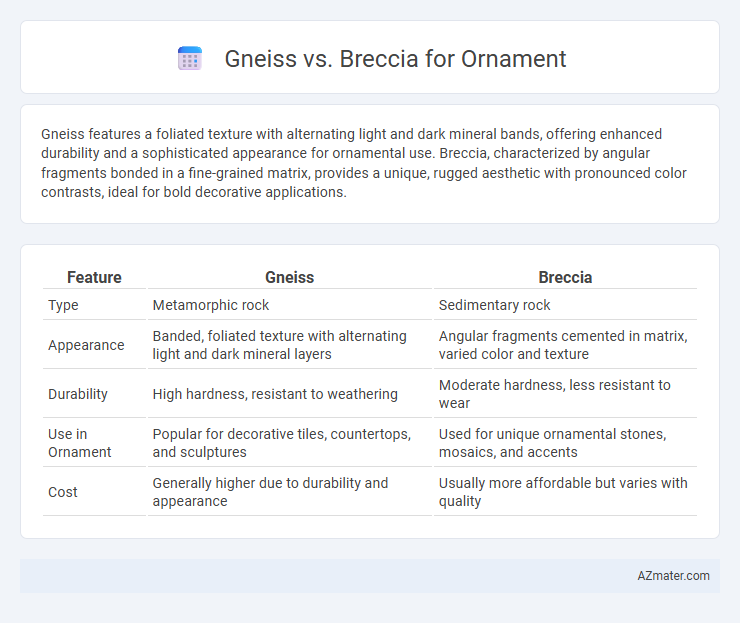Gneiss features a foliated texture with alternating light and dark mineral bands, offering enhanced durability and a sophisticated appearance for ornamental use. Breccia, characterized by angular fragments bonded in a fine-grained matrix, provides a unique, rugged aesthetic with pronounced color contrasts, ideal for bold decorative applications.
Table of Comparison
| Feature | Gneiss | Breccia |
|---|---|---|
| Type | Metamorphic rock | Sedimentary rock |
| Appearance | Banded, foliated texture with alternating light and dark mineral layers | Angular fragments cemented in matrix, varied color and texture |
| Durability | High hardness, resistant to weathering | Moderate hardness, less resistant to wear |
| Use in Ornament | Popular for decorative tiles, countertops, and sculptures | Used for unique ornamental stones, mosaics, and accents |
| Cost | Generally higher due to durability and appearance | Usually more affordable but varies with quality |
Introduction: Gneiss vs Breccia in Ornamentation
Gneiss and breccia are both popular choices in ornamental design due to their unique textures and visual appeal. Gneiss features distinct, banded mineral patterns resulting from high-grade metamorphism, offering a sleek, linear aesthetic ideal for sophisticated interiors. Breccia, composed of angular rock fragments cemented together, provides a striking, fragmented appearance that adds dynamic contrast and boldness to decorative applications.
Geological Formation of Gneiss and Breccia
Gneiss forms through high-grade regional metamorphism, where intense heat and pressure realign mineral grains into distinct foliation bands, typically originating from igneous or sedimentary rocks. Breccia results from mechanical weathering or tectonic activity, characterized by angular rock fragments cemented by finer material during sedimentary or volcanic processes. The foliated texture of gneiss contrasts with breccia's clastic composition, influencing their ornamental applications based on geological origin and mineral stability.
Visual Appearance and Color Variations
Gneiss features a distinct banded or foliated texture with alternating light and dark mineral layers, offering a sophisticated, striped visual appearance ideal for ornamental purposes. Breccia showcases a chaotic mosaic of angular rock fragments cemented together, providing a dramatic and striking pattern with diverse color variations ranging from earthy tones to vibrant hues. The contrast between gneiss's linear patterns and breccia's fragmented, colorful composition makes each uniquely suitable for decorative applications depending on the desired aesthetic impact.
Texture and Surface Characteristics
Gneiss features a foliated texture with alternating light and dark mineral bands, offering a smooth, layered surface ideal for elegant ornamentation, while breccia consists of angular, fragmented clasts cemented together, creating a rough, textured surface with a mosaic-like appearance. The coarse, heterogeneous texture of breccia provides distinctive visual interest and rugged charm, contrasting with the finely layered, polished finish of gneiss. Both stones offer unique aesthetic qualities, with gneiss emphasizing sophistication through its banded pattern, and breccia showcasing natural complexity and bold texture.
Durability and Weather Resistance
Gneiss exhibits superior durability and weather resistance compared to breccia, due to its foliated, tightly interlocking mineral grains that enhance structural strength. Breccia, composed of angular rock fragments cemented together, tends to be more porous and less resistant to weathering, making it more susceptible to chipping and erosion over time. For ornamental applications requiring long-lasting performance in outdoor environments, gneiss is generally preferred for its robustness against moisture, temperature fluctuations, and physical wear.
Applications in Decorative Design
Gneiss offers a visually appealing, banded texture with high durability, making it ideal for sophisticated countertops, flooring, and wall cladding in decorative design. Breccia, characterized by its angular, fragmented appearance and vibrant color variations, is favored for creating striking accent pieces, mosaics, and statement surfaces. Both stones enhance interior aesthetics, but gneiss's granular structure suits polished finishes, while breccia's composition lends itself to dramatic, artistic applications.
Maintenance and Longevity
Gneiss offers superior durability and low maintenance due to its tightly interlocked mineral grains, making it resistant to weathering and scratches, ideal for long-lasting ornamental use. Breccia, while visually striking with its angular fragments, tends to be more porous and fragile, requiring regular sealing and careful upkeep to prevent chipping and staining. Gneiss typically outperforms Breccia in longevity, maintaining its aesthetic appeal with minimal intervention over time.
Cost Comparison and Availability
Gneiss is generally more affordable and widely available due to its common geological occurrence and ease of quarrying, making it a cost-effective choice for ornamental purposes. Breccia, characterized by its unique angular fragments and rarity, tends to be more expensive and less accessible, often sourced from specific locations with limited deposits. The price differential between Gneiss and Breccia reflects their respective availability and the complexity of extraction and processing for decorative use.
Sustainability and Environmental Impact
Gneiss and breccia differ significantly in sustainability and environmental impact when used as ornamental stones. Gneiss, a metamorphic rock, is more durable and requires less frequent replacement, reducing long-term resource consumption and waste. Breccia, characterized by its fragmented composition, often demands extensive quarrying and processing, which increases energy use and environmental degradation compared to the more resilient and eco-friendly properties of gneiss.
Choosing the Best Stone: Gneiss or Breccia for Ornamentation
Gneiss offers a durable, foliated texture with intricate banding ideal for sophisticated ornamentation, while breccia presents a bold, fragmented appearance with angular clasts that create dramatic visual impact. When choosing the best stone for ornamentation, consider gneiss for elegance and longevity in high-traffic settings, and breccia for striking, decorative features with a unique, rugged aesthetic. Both stones vary in hardness and color patterns, so selection depends on the desired balance between durability and ornamental appeal.

Infographic: Gneiss vs Breccia for Ornament
 azmater.com
azmater.com